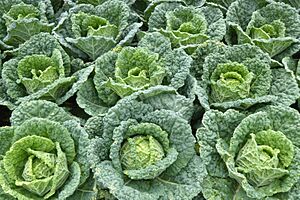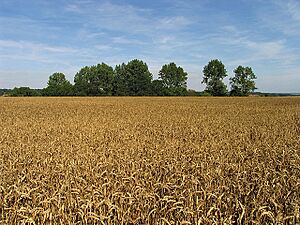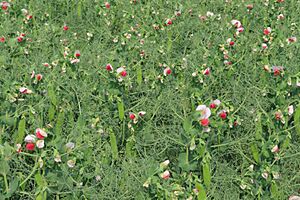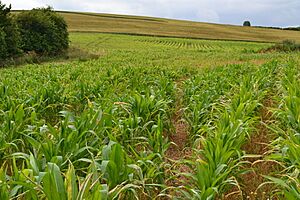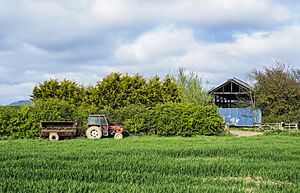Crop facts for kids
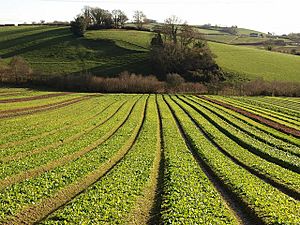
Crops are special plants that farmers grow on purpose. Most crops are used for food, like grains, vegetables, and fruit. But crops can also be grown for other important things, such as medicines (like quinine), fibers for clothes (like cotton), or materials like rubber and wood.
Imagine a world without crops – it would be very different! Crops are fundamental to our daily lives, providing us with sustenance, materials, and energy.
Contents
What Are Crops?
Crops are living plants that people grow for a specific reason. Farmers usually grow just one type of crop in a large area, which is called a monoculture. These plants are not wild; they are domesticated. This means humans have carefully chosen and grown them over many years. Through a process called artificial selection, farmers pick the best plants to grow more of. This helps make crops bigger, tastier, or better for their intended use.
Why Do We Grow Crops?
Crops are super important for human life. They provide us with food, materials, and even energy.
Food Crops
The most common reason to grow crops is for food.
- Grains: These include wheat, rice, and corn. They are a main part of the diet for many people around the world.
- Vegetables: Such as carrots, potatoes, broccoli, and spinach. They give us important vitamins and minerals.
- Fruits: Like apples, oranges, and bananas. They are often sweet and full of nutrients.
- Legumes: These are plants like beans, peas, and lentils. They are a great source of protein.
Fiber Crops
Some crops are grown to make fibers. These fibers are used to create clothes, ropes, and other textiles.
- Cotton: This is one of the most widely grown fiber crops. Its soft fibers are used to make many types of fabric.
- Flax: Used to make linen fabric.
- Hemp: Can be used for strong ropes and fabrics.
Other Important Crops
Crops are also used for many other purposes:
- Medicinal crops: Plants like quinine are grown to make medicines that help people get better.
- Rubber crops: The rubber tree produces a sap that is turned into rubber, used in tires and many other products.
- Wood crops: Trees grown in forestry are a type of crop, providing wood for building and paper.
- Biofuel crops: Some crops, like corn or sugarcane, can be used to create biofuels, which are fuels made from living things.
What Kinds of Crops Are Produced Most?
In 2022, certain types of crops were produced in much larger quantities than others:
- Cereals: These were the main group of crops, including grains like wheat, rice, and maize (corn). They form the backbone of many diets around the world.
- Sugar Crops: These came in second, making up 23% of the total production. Think of sugarcane and sugar beets, which are used to make sugar.
- Vegetables: These accounted for 12% of the total.
- Oil Crops: Also 12%, these include plants like soybeans, sunflowers, and palm trees, from which we get cooking oils.
- Fruit: These made up 10% of the total production.
The "Big Four" Crops
Out of all the crops grown, four stand out because they account for about half of all global primary crop production:
- Sugar Cane: A tall grass grown for its sweet juice, used to make sugar.
- Maize (Corn): A versatile grain used for food, animal feed, and even fuel.
- Wheat: A staple grain used to make bread, pasta, and many other foods.
- Rice: A primary food source for billions of people, especially in Asia.
These four crops are incredibly important for feeding the world!
Methods of Cropping
- Monocropping: This is when a farmer grows only one specific crop in a field, year after year. While it can be simple to manage, mono cropping has a big disadvantage: it can make the soil lose its fertility over time. Each crop takes specific nutrients from the soil, and if the same crop is grown repeatedly, those nutrients can get depleted, making the soil less healthy for future plants.
- Crop Rotation: To combat the problems of mono cropping, farmers often use crop rotation. This involves growing different types of crops in the same field in a planned sequence over several seasons. For example, a farmer might grow corn one year, then soybeans the next, and then wheat. Different crops have different nutrient needs and can even put nutrients back into the soil (like legumes, which add nitrogen). This helps keep the soil healthy and productive.
- Sequential Cropping: This method involves growing two or more crops in the same field within a single year, but one after the other. For instance, a farmer might harvest an early-season crop and then immediately plant a different, late-season crop in the same field.
- Intercropping: This is when two or more crops are grown together in the same field at the same time. They might be planted in alternating rows or mixed together. This can help with pest control, improve soil health, and make more efficient use of land and resources.
- Relay Cropping: This is a special type of sequential or intercropping where a second crop is planted before the first crop is harvested. Imagine planting a new crop between the rows of an existing crop that is almost ready for harvest. This method can solve several challenges, such as making better use of available resources (like sunlight and water), helping with tricky sowing times, optimizing fertilizer application, and reducing soil degradation. The result of using relay cropping is often a higher overall crop output from the same piece of land.
Images for kids
-
Crops drying in a home in Punjab, India
See also
 In Spanish: Producto agrícola para niños
In Spanish: Producto agrícola para niños


